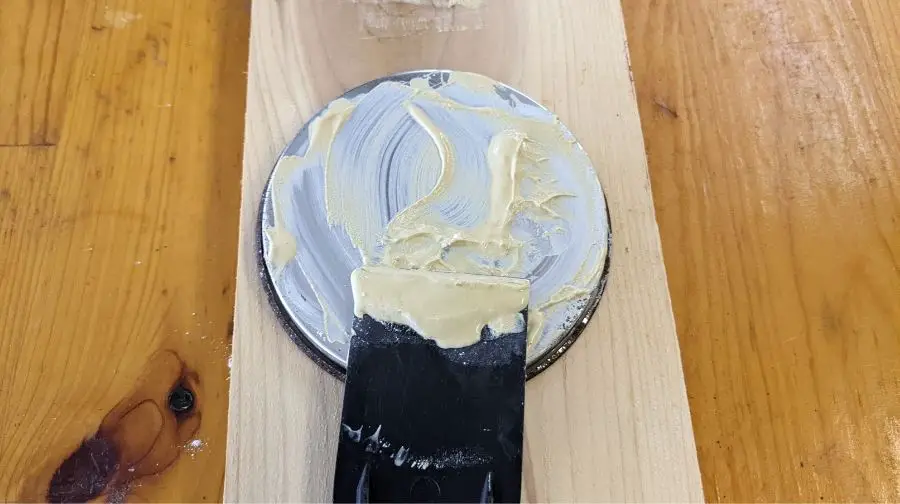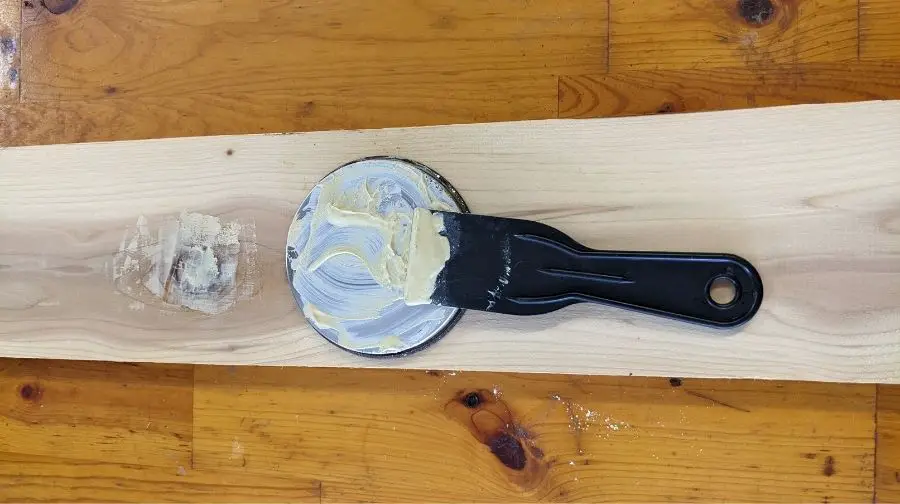
When you are woodworking, there may be times when you need to fill in a hole or a crack. This is where wood filler comes in handy. Wood filler can be applied in many different ways, depending on the project that you are working on. In this blog post, we will discuss the thickness of wood filler and how it can be used to achieve the desired results.
How Thick Can Wood Filler Be Applied?
In general most wood fillers can be applied up to around 1/4 – 3/4 inch thick layers. It is important to note that if you are applying a thicker layer of wood filler, you will need to allow for adequate drying time. If you are working with a wood filler that is not water-based, then you will also need to take into account the fact that it may shrink as it dries.
There are a few exceptions to the rule about applying wood filler no thicker than ¼ inch. One exception is if you are using a two-part wood filler. This type of wood filler is designed to be used in thicker applications and can be applied up to around ½ inch thick.
Another exception is if you are using a putty knife to apply the wood filler. If you are using a putty knife, then you can apply the wood filler in much thinner layers. In fact, you can use a putty knife to apply wood filler in layers that are as thin as you like.
If you are unsure about how thick you can apply the wood filler, it is always best to consult the manufacturer’s instructions. The instructions will give you the maximum thickness that you can safely apply without damaging the wood filler.
Can You Use Wood Filler For Large Gaps?
Wood filler can be applied in a number of ways, depending on the size and shape of the gap that needs to be filled. If you are trying to fill a large hole or gap, then you will need to use a thicker wood filler than if you are just filling in some small cracks. You may also need to apply it in multiple layers in order to get a smooth finish.
If you are using wood filler for a large gap, it is important to make sure that the surface is clean and dry before you start. You should also rough up the surface slightly so that the filler will adhere better. Apply the filler in thin layers, letting each layer dry completely before adding another. You may need to sand the surface after the filler has dried in order to get a smooth finish.
Putty Wood Filler HEAD-TO-HEAD
Subscribe to Craftswright on YouTube
Which Is Better Wood Putty Or Wood Filler?
The rule of thumb is to use wood putty on finished projects and wood filler on unfinished projects. This is because you will need to match your wood putty color to the stain color of your project. You are able to stain or paint over your wood filler.
Can You Build Up Wood Filler?
Yes, you can build up wood filler. This is a great way to get the desired thickness without having to use multiple applications. Apply your wood filler in 1/4 in layers allowing to dry in between each layer.
Just make sure that the filler is completely dry before sanding it down. Otherwise, you’ll end up with a gooey mess.
One thing to keep in mind is that wood filler isn’t meant to be a structural material. So, if you’re filling in a large hole, you’ll want to reinforce it with something like dowels or screws. Otherwise, the filler will eventually crack and fall out.
Why Does My Wood Filler Keep Cracking?
One of the most common problems with wood filler is that it tends to crack. This can be a real pain, especially if you’ve put in a lot of hard work filling in all those gaps and dings in your woodworking project. So what’s causing this problem, and more importantly, how can you prevent it?
There are a few different reasons why wood filler might crack. One of the most common is that the filler isn’t compatible with the type of wood you’re using it on. For example, if you’re using a water-based wood filler on an oily piece of wood, it’s not going to adhere properly and is more likely to crack.
Another common reason for wood filler cracking is that it’s not applied in a thick enough layer. If the filler isn’t given enough time to cure properly, it can crack as it dries. Make sure you apply the filler in several thin layers rather than one thick one, and give each layer plenty of time to dry before applying the next.
What Is The Strongest Wood Filler?

DAP Plastic Wood All Purpose Wood Filler is the strongest wood filler I’ve ever used. It’s great for repairing cracks, holes, and damage in woodworking projects. This wood filler can be applied up to a thickness of ¼ inch without sagging or shrinking. It’s also sandable and paintable, so it’s perfect for finishing projects.
It dries quickly, so it’s perfect for both indoor and outdoor projects.
The All Purpose Wood Filler is available in three different sizes: a two-ounce squeeze tube, a four-ounce jar, or an eight-ounce tub. The two-ounce size is perfect for small projects, while the eight-ounce size is great for larger projects.
DAP also offers a Heavy Duty Wood Filler that is perfect for more demanding applications. This filler can be applied in thicknesses up to three inches, making it ideal for large projects such as furniture or deck repairs.

Minwax Stainable Wood Filler is also a good choice for woodworking projects. It can be applied in thicknesses up to ¾ inch, and it’s available in a variety of colors to match your project.
How Long Does Wood Filler Take To Harden?
Wood filler takes between 2-4 hours to harden depending on the thickness of it’s layer. The thicker the layer of wood filler, the longer it will take to harden. You can speed up the process by using a hair dryer on low heat or by placing the wood in direct sunlight.




